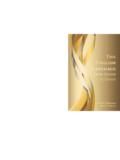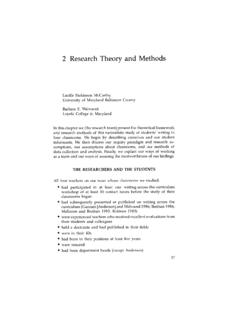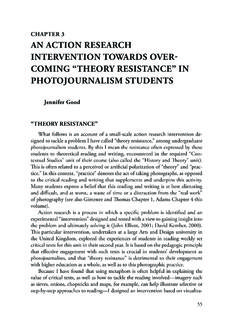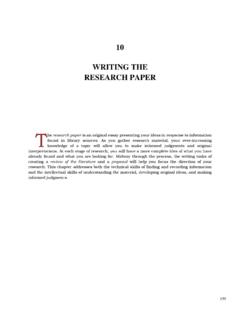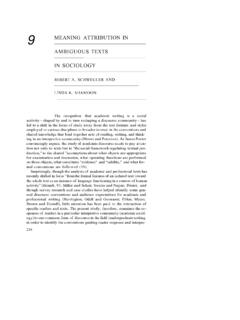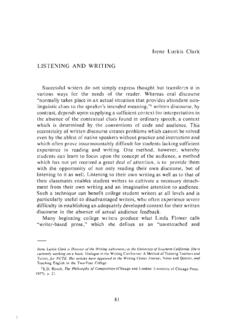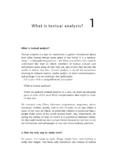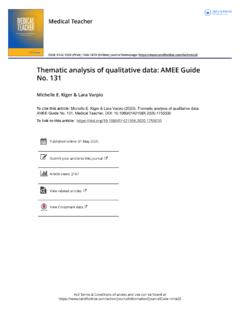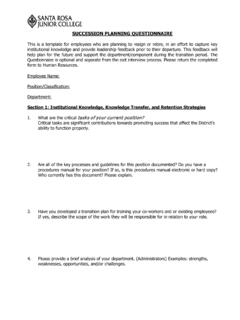Transcription of Backpacks vs. Briefcases: Steps toward Rhetorical Analysis
1 Backpacks vs. Briefcases: Steps toward Rhetorical Analysis by Laura Bolin Carroll This essay is a chapter in Writing Spaces: Readings on Writing, Volume 1, a peer-reviewed open textbook series for the writing classroom, and is published through Parlor Press. The full volume and individual chapter downloads are available for free from the following sites: Writing Spaces: Parlor Press: WAC Clearinghouse: Print versions of the volume are available for purchase directly from Parlor Press and through other booksellers. To learn about participating in the Writing Spaces project, visit the Writing Spaces website at This essay is available under a Creative Commons License subject to the Writing Spaces Terms of Use.
2 More information, such as the specific license being used, is available at the bottom of the first page of the chapter. 2010 by the respective author(s). For reprint rights and other permissions, contact the original author(s). Library of Congress Cataloging-in-Publication Data Writing spaces : readings on writing. Volume 1 / edited by Charles Lowe and Pavel Zemliansky. p. cm. Includes bibliographical references and index. ISBN 978-1-60235-184-4 (pbk. : alk. paper) -- ISBN 978-1-60235-185-1. (adobe ebook). 1. College readers. 2. English language--Rhetoric. I. Lowe, Charles, 1965- II. Zemliansky, Pavel. 2010. 808'.0427--dc22. 2010019487. Backpacks vs.
3 Briefcases: Steps toward Rhetorical Analysis Laura Bolin Carroll First Impressions Imagine the first day of class in first year composition at your universi- ty.* The moment your professor walked in the room, you likely began analyzing her and making assumptions about what kind of teacher she will be. You might have noticed what kind of bag she is carrying a tattered leather satchel? a hot pink polka-dotted backpack ? a burgun- dy brief case? You probably also noticed what she is wearing trendy slacks and an untucked striped shirt? a skirted suit? jeans and a tee shirt? It is likely that the above observations were only a few of the ob- servations you made as your professor walked in the room.
4 You might have also noticed her shoes, her jewelry, whether she wears a wedding ring, how her hair is styled, whether she stands tall or slumps, how quickly she walks, or maybe even if her nails are done. If you don't tend to notice any of these things about your professors, you certain- ly do about the people around you your roommate, others in your residence hall, students you are assigned to work with in groups, or a * This work is licensed under the Creative Commons Attribution- Noncommercial-Share Alike United States License and is subject to the Writing Spaces Terms of Use. To view a copy of this license, visit http://. or send a letter to Creative Commons, 171 Second Street, Suite 300, San Francisco, California, 94105, USA.
5 To view the Writing Spaces Terms of Use, visit http://writingspaces. org/terms-of-use. 45. 46 Laura Bolin Carroll prospective date. For most of us, many of the people we encounter in a given day are subject to this kind of quick Analysis . Now as you performed this kind of Analysis , you likely didn't walk through each of these questions one by one, write out the answer, and add up the responses to see what kind of person you are interacting with. Instead, you quickly took in the information and made an in- formed, and likely somewhat accurate, decision about that person. Over the years, as you have interacted with others, you have built a mental database that you can draw on to make conclusions about what a person's looks tell you about their personality.
6 You have become able to analyze quickly what people are saying about themselves through the way they choose to dress, accessorize, or wear their hair. We have, of course, heard that you can't judge a book by its cover, . but, in fact, we do it all the time. Daily we find ourselves in situations where we are forced to make snap judgments. Each day we meet differ- ent people, encounter unfamiliar situations, and see media that asks us to do, think, buy, and act in all sorts of ways. In fact, our saturation in media and its images is one of the reasons why learning to do rhetori- cal Analysis is so important. The more we know about how to analyze situations and draw informed conclusions, the better we can become about making savvy judgments about the people, situations and media we encounter.
7 Implications of Rhetorical Analysis Media is one of the most important places where this kind of Analysis needs to happen. Rhetoric the way we use language and images to persuade is what makes media work. Think of all the media you see and hear every day: Twitter, television shows, web pages, billboards, text messages, podcasts. Even as you read this chapter, more ways to get those messages to you quickly and in a persuasive manner are be- ing developed. Media is constantly asking you to buy something, act in some way, believe something to be true, or interact with others in a specific manner. Understanding Rhetorical messages is essential to help us to become informed consumers, but it also helps evaluate the ethics of messages, how they affect us personally, and how they affect society.
8 Take, for example, a commercial for men's deodorant that tells you that you'll be irresistible to women if you use their product. This cam- Steps toward Rhetorical Analysis 47. paign doesn't just ask you to buy the product, though. It also asks you to trust the company's credibility, or ethos, and to believe the messages they send about how men and women interact, about sexuality, and about what constitutes a healthy body. You have to decide whether or not you will choose to buy the product and how you will choose to respond to the messages that the commercial sends. Or, in another situation, a Facebook group asks you to support health care reform.
9 The rhetoric in this group uses people's stories of their struggles to obtain affordable health care. These stories, which are often heart-wrenching, use emotion to persuade you also called pathos. You are asked to believe that health care reform is necessary and urgent, and you are asked to act on these beliefs by calling your congresspersons and asking them to support the reforms as well. Because media rhetoric surrounds us, it is important to understand how rhetoric works. If we refuse to stop and think about how and why it persuades us, we can become mindless consumers who buy into arguments about what makes us value ourselves and what makes us happy.
10 For example, research has shown that only 2% of women con- sider themselves beautiful ( Campaign ), which has been linked to the way that the fashion industry defines beauty. We are also told by the media that buying more stuff can make us happy, but historical sur- veys show that US happiness peaked in the 1950s, when people saw as many advertisements in their lifetime as the average American sees in one year (Leonard). Our worlds are full of these kinds of social influences. As we in- teract with other people and with media, we are continually creating and interpreting rhetoric. In the same way that you decide how to pro- cess, analyze or ignore these messages, you create them.

